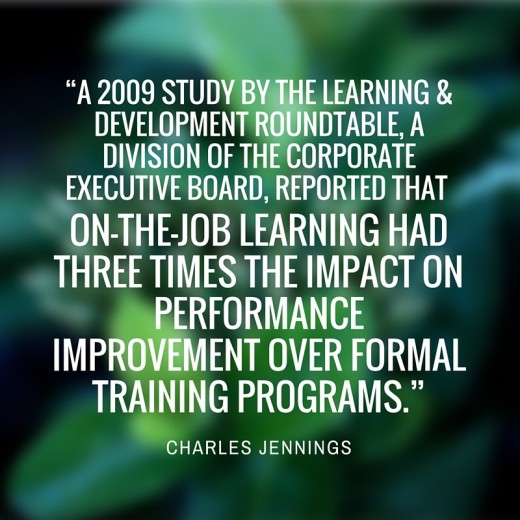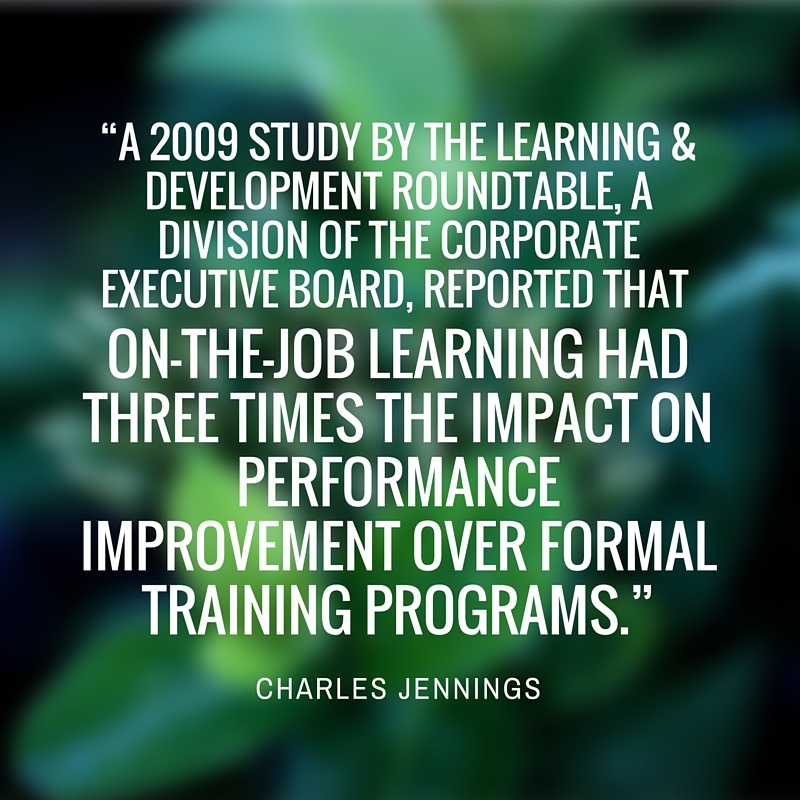Embed Learning in the Workflow for Greater Results
January 25, 2016

There have been so many studies done and results published insisting that one-off training isn’t very effective. We use that phrase—one-off training—quite a bit on this blog. For new readers (hello, thanks for joining!) we use that phrase to describe training that’s done with zero follow-up or accountability. The audience participates in the class whether in-person or online, and then they’re done. These courses are created and delivered with the expectation that the participants will not only retain the entire heap of information that’s been dumped on them, but be able to execute that new knowledge on-the-job.
Let’s look at one very telling statistic discovered by three different sources:
- Up to 80% of new skills are lost within 1 week of training if not used (ASTD)
- 87% of new skills are lost within a month of the training (Xerox)
- Without reinforcement, learners will likely forget 80% of training material within 90-120 days. (Sales Readiness Group)
Edgar Dale’s Cone of Experience tells us that people remember 90% of what they do, which means on-the-job learning is much more effective than, say, classroom-only training.
 Furthermore, what these numbers tell us is that we absolutely must do more to help people apply new knowledge. The whole point of training is to help people be better at something, and only teaching them once is doing them a huge disservice.
Furthermore, what these numbers tell us is that we absolutely must do more to help people apply new knowledge. The whole point of training is to help people be better at something, and only teaching them once is doing them a huge disservice.
We can make training much more effective by extending the learning beyond just one session. It’s even more impactful when it’s broken into bite-sized chunks and embedded into the workflow, so that’s readily available and consumed at the highest point of need, i.e. while on-the-job.
Is Embedded Learning Different From Performance Support?
With so much terminology flying around in the industry, it can be hard to know whether terms represent different concepts, or if they’re actually addressing the same thing.
Embedded learning and performance support, while related, are not quite the same thing. Performance Support can include job aids, procedural checklists, diagrams, instructional photos or videos, and is a subcategory of embedded learning focused specifically on the successful completion of a task or process. Embedded Learning is a broader term that includes performance support materials, but also social/collaborative learning between peers or with supervisors, coaching tools, microlearning, or even training reminders and memory jogs delivered by email or SMS. The key is that embedded learning breaks down the silo between work and training.
Why Learning Should Be Embedded in the Workflow
- As the training and work silos are broken down, you’ll be able to take advantage of the vast amount of knowledge that already exists within your organization. Getting buy-in and support from subject matter experts for a training course can be tough, but empowering them to share knowledge as part of their typical day is easier.
- Once audience members experience the added value of on-the-job learning that helps their performance, they should embrace it and help spread additional knowledge themselves.
- Impact can be immediate. If someone finds a resource that helps them complete a task better or faster, their performance has been improved and will continue to improve each time they perform that task.
- Embedded learning improves the effectiveness of formal training by providing reinforcement and coaching. It reduces the retention problem we addressed at the beginning of this post.
- It may reduce the need for formal training, or at least give an organization flexibility in determining the best modality for delivering training based on subject matter. Resources can be allocated in a smarter way.
- The contextual nature of embedded learning makes it effective and impactful right away. It’s better absorbed and retained when put in context of day-to-day work.
- It lends itself to a broad spectrum of multimedia, allowing users to access learning on mobile devices on the go or at their workstation. Everything from printed materials to wearable device applications can work.
- With the right measures in place, we should be able to determine the impact on desired outcomes.
You’ve decided you want to give this a shot. Now the question is, where can you embed learning items?
The best solution will vary depending on role. For example, something accessible from a mobile device might be necessary for some teams, while others are fine to have desktop access or even printed materials they see every day. Give consideration to the following:
- An employee intranet
- An organizational social collaboration tool
- A corporate training or employee management portal
- Work systems
- A custom mobile app
- Email or text message
- Procedural Checklists – we’re big fans of electronic, interactive ones
- And more…what ideas do you have?
Before You Begin, Know the Potential Challenges
Implementing any new learning program will come with a set of challenges. Plan to address hurdles before they appear. Some you might encounter are:
- Embedded learning could, at least initially, increase “time-on-task”. That’s not necessarily a bad thing, because you’re trading speed for effectiveness. Track this over time and watch for improvement.
- Be sure you’ve thought through how to organize the learning tools in a way that makes it easy to find, easy to use, and readily available.
- Embedded learning is very different from formal learning, and can’t be managed the same way. L&D teams should expect an adjustment period.
- You will need to get managerial support so that employees are encouraged to use it. Adoption can be slow at first, as with any new system. The less the employee has to adapt (the better you can truly embed the learning into their day) the better results you’ll see.
photo credit: Brian Taylor, Auto Wrapping Process at AMPORTS
Business & Finance Articles on Business 2 Community
(34)














